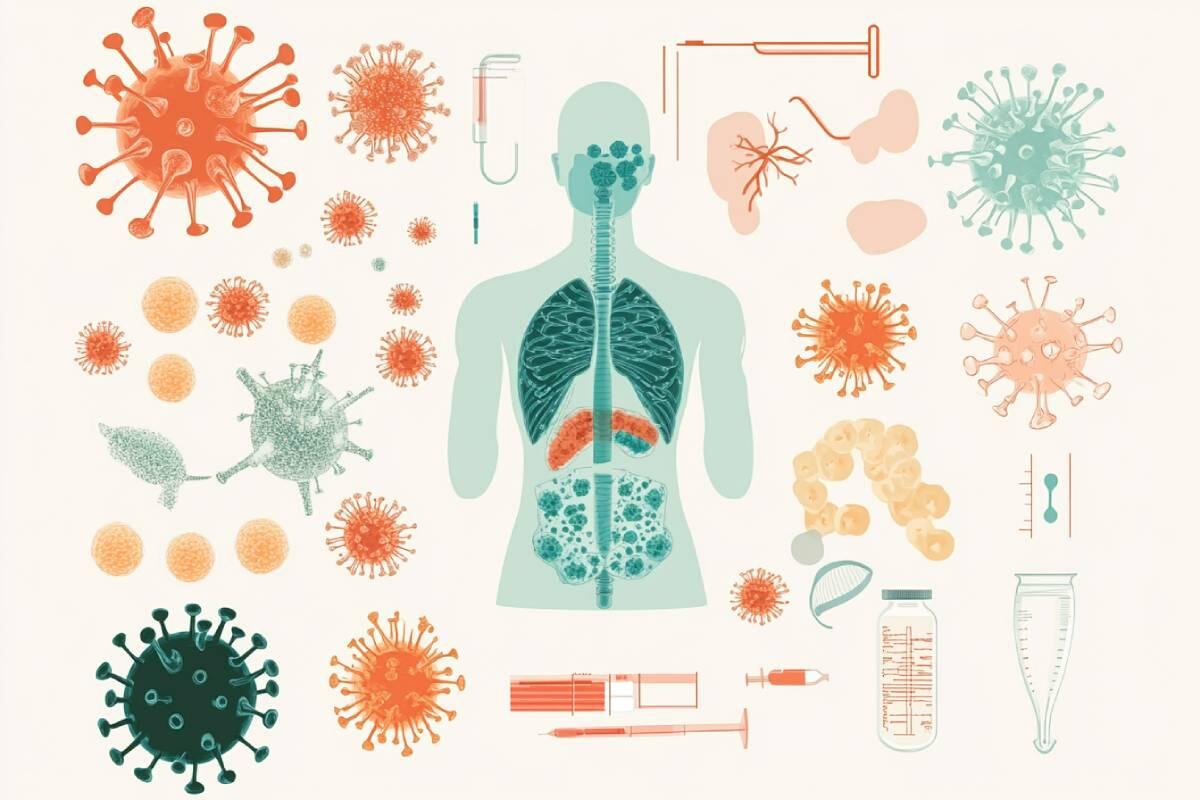Viral Infections: What They Are, Types, Symptoms, and Prevention
It is very common for people to visit a doctor when feeling unwell and receive the diagnosis of "viral infection." But what exactly does this term mean?
Viral infections are caused by viruses and can affect different systems in the body, leading to mild symptoms or serious conditions that require medical attention.
Understanding the different types of viral infections, their symptoms, and how to prevent them is essential for maintaining health and protecting the community. In this article, we provide key information about viral infections, including tips on diagnosing, treating, and preventing them.
What Are Viral Infections?
Viral infections are caused by viruses that affect different parts of the body, such as the respiratory, gastrointestinal, nervous systems, or the skin.
Viruses are extremely small microorganisms that need a host cell to replicate. Depending on the cells and systems they infect, they can cause mild illnesses or severe infections.
📌 According to the World Health Organization (WHO), viral infections are among the leading causes of morbidity and mortality worldwide. Common examples include influenza, dengue, viral hepatitis, and COVID-19.
Main Types of Viral Infections
There are different types of viral infections, and their symptoms, diagnosis, and prevention can vary. Below are the most common types:
1. Respiratory Viral Infections
These infections affect the respiratory system. Common viruses include:
✔ Influenza (flu)
✔ Respiratory syncytial virus (RSV)
✔ Coronavirus
📌 A study published in Nature Medicine (2021) showed that the transmissibility of respiratory viruses can be reduced by up to 70% with the proper use of face masks.
2. Gastrointestinal Viral Infections
These infections affect the digestive tract, causing diarrhea, vomiting, and abdominal pain. Examples include:
✔ Rotavirus
✔ Norovirus
✔ Adenovirus
📌 According to WHO data, rotavirus is one of the leading causes of severe diarrhea in children.
3. Skin Viral Infections
These infections cause skin lesions, such as warts and rashes. Examples include:
✔ Chickenpox (varicella-zoster virus)
✔ Herpes simplex
✔ Molluscum contagiosum
4. Vector-Borne Viral Infections
These infections are common in tropical countries, transmitted by insects, such as mosquitoes. Examples include:
✔ Dengue
✔ Zika
✔ Yellow fever
✔ Chikungunya
📌 A study published in Lancet Infectious Diseases (2020) highlighted that implementing mosquito control measures reduced chikungunya cases by over 50% in tropical communities.
Symptoms of Viral Infections
Symptoms vary depending on the virus type and the affected area of the body.
Common Symptoms
✔ Fever
✔ General malaise
✔ Headache
✔ Fatigue
✔ Loss of appetite
Specific Symptoms
✔ Respiratory infections → Cough, nasal congestion, sore throat
✔ Gastrointestinal infections → Diarrhea, vomiting, stomach cramps
✔ Skin infections → Rashes, blisters, itching
✔ Vector-borne infections → Joint pain, red spots on the skin
Diagnosis of Viral Infections
Diagnosis is usually made by a doctor, based on clinical history, symptoms, and, when necessary, laboratory tests.
✔ Rapid tests can detect specific viruses, such as influenza and COVID-19.
Treatment for Viral Infections
In most cases, treatment is symptomatic, meaning it focuses on relieving symptoms while the immune system fights the infection.
General Recommendations
✔ Adequate rest
✔ Hydration
✔ Fever and pain medications (under medical supervision)
✔ Light diet
Specific Treatments
In severe cases, antivirals may be prescribed, such as:
✔ Oseltamivir → For influenza
✔ Remdesivir → For COVID-19
📌 A clinical study published in the New England Journal of Medicine (2022) showed that early use of antivirals in high-risk COVID-19 patients reduced mortality by 30%.
Prevention of Viral Infections
Since viral infections are highly contagious, prevention is crucial to avoiding outbreaks.
General Measures
✔ Hand hygiene: Washing hands with soap and water for at least 20 seconds is one of the most effective ways to prevent viral infections.
✔ Use of hand sanitizer: When soap and water are unavailable, 70% alcohol-based sanitizer is an effective alternative.
✔ Vaccination: Keeping the vaccination schedule updated helps prevent diseases such as influenza, hepatitis, and yellow fever.
✔ Avoid close contact with infected individuals: Especially during viral outbreaks.
✔ Ventilated environments: Promoting air circulation reduces the transmission of respiratory viruses.
📌 A systematic review published in the Journal of Infection Prevention (2023) found that the combination of vaccination and hygiene measures can reduce the spread of respiratory viral infections by over 80%.
Specific Precautions
✔ Prevention of vector-borne infections → Use of repellents, long-sleeved clothing, and eliminating mosquito breeding sites.
✔ Prevention of gastrointestinal infections → Consuming safe drinking water and properly sanitized food.
Although most of these infections have a benign course, it is essential to watch for severe symptoms and seek medical attention when necessary.
